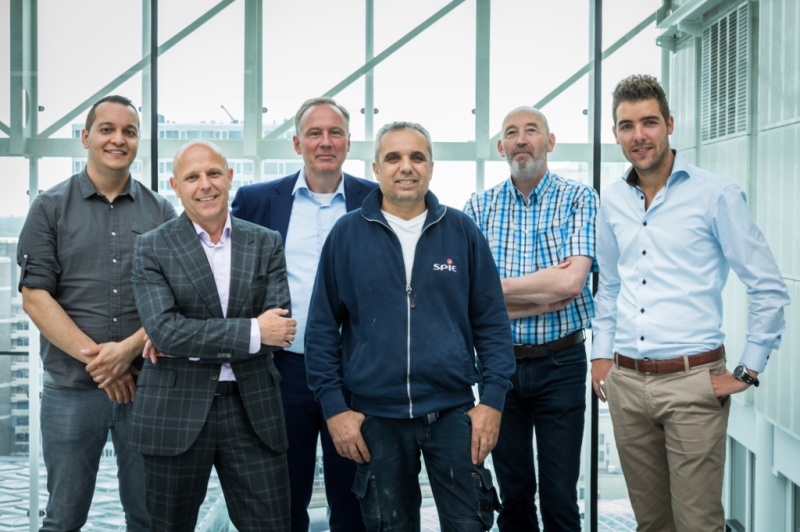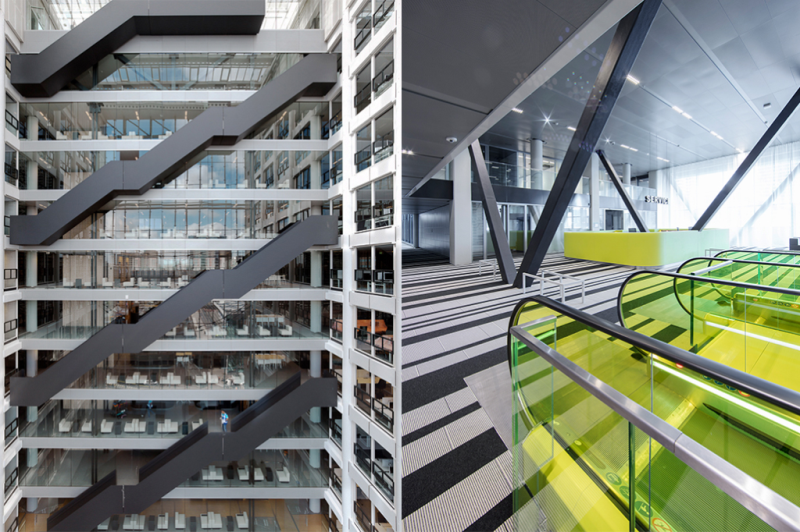 BAM, SPIE and R&M develop a network for the Government Office of the future.
BAM, SPIE and R&M develop a network for the Government Office of the future.
The extensive renovation of the former Ministry of Housing, Spatial Planning and Environment is almost complete. The landmark Rijnstraat 8 building in Den Haag is the first collective government office and one of the largest in the Netherlands. It has been designed to be used by multiple governmental organizations and to meet the widest possible variety of organizational and personal needs.
Societal and technological developments are changing civil servants’ work. The government’s policy for working environments is based on the idea that buildings should focus on providing facilities for meeting, networking, consultation and collaboration. Rijnstraat 8 has been optimized for exactly these tasks.
Making the existing property suitable for its new purpose was a vast undertaking, realized by the Poort Centraal Partnership involving The Royal BAM Group (BAM), ISS Facility Services and the Office for Metropolitan Architecture (OMA). The project featured stringent requirements for construction, IT infrastructure and logistics processes, as well as a contract form that is relatively new to many parties in the construction business: the Public-Private Cooperation. BAM, SPIE and R&M, responsible for the extensive network infrastructure, managed to get this enormous job done thanks to close cooperation, fresh ideas and smart use of technological resources.
The new government office is built and managed under a DBFMO (Design Build Finance Maintain and Operate) contract. This implies that BAM and its partners are responsible for construction as well as long-term building maintenance and development. The government required a 25 year guarantee, the network concept had to provide a platform for tomorrow’s services and technologies.
 Design first, then build
Design first, then build
“BAM set up the entire project, including new construction work, in detail in a BIM (Building Information Model) environment. This type of digital model allows a construction to be virtually built up of objects to which information is linked,” explains Ron Meester, Project Manager BAM Large Projects. “BAM is a leader in this type of virtual building and we were able to prepare the network and cabling in detail. Potentially troublesome connections could be identified in advance using BIM. Routes were accurately defined and lengths and tolerances precisely calculated. R&M and SPIE confidently pre-fabricated the network based on BIM data. Design of the network and all cabling in BIM perfectly matched up with the final installation, with virtually no material loss: every meter of cable was used. In addition, a significant amount of time was saved by having cabling prefabricated away from the project location.”
 Ambitious schedule and architectural highlights
Ambitious schedule and architectural highlights
BAM, SPIE and R&M worked closely together from the preparation of the project to its implementation. In certain periods, the three parties held daily consultations to monitor progress, look for solutions and speed up the process where possible. The project site is in a busy area next to The Hague Central Station, which makes deliveries very difficult. Furthermore, available storage space was limited. Construction schedules were very tight and multiple construction projects had to be managed simultaneously.
In developing the network proposal, R&M needed to take into account the Dutch state’s formal requirements regarding availability and scalability. Also, allowances for the strict security requirements of the Ministry of Foreign Affairs had to be made.
Far-reaching digitization
The IT network needs to support a wide variety of devices and platforms: office PCs, network connections, WiFi, camera security, internal presentation systems, narrowcasting, sun blinds, ticketing and numbering systems, access and purchasing systems. Even the lockers are connected to the network.
In order to address bandwidth needs, which are expected to grow rapidly, R&M recommended several network modifications. For example, the tender specified Multimode fibre optic cable for the backbone. However, R&M advised more future-proof Singlemode. The building’s network foundation offers plenty of scope for expanding services later. It also facilitates making building management increasingly smart.
Ready for R&MinteliPhy
BIM offers all parties a highly detailed building-specific knowledge base. A must-have in this case, as all the parties involved will jointly be taking care of the building for the next 25 years, including extensions and adjustments.
The next phase will be implementing R&MinteliPhy Manage. For this reason, a project with BAM’s BIM team was implemented to investigate whether the BIM environment could be linked to the R&MinteliPhy system for Automated Infrastructure Management. Another possible future expansion of the network will be the implementation of R&M Monitoring. As a result, parts of the network could be monitored in real-time, and changes and mutations on the network could be performed more efficiently and cost-effectively. All R&M panels in the network are R&MinteliPhy ready, which allows them to be customized at a later stage.

